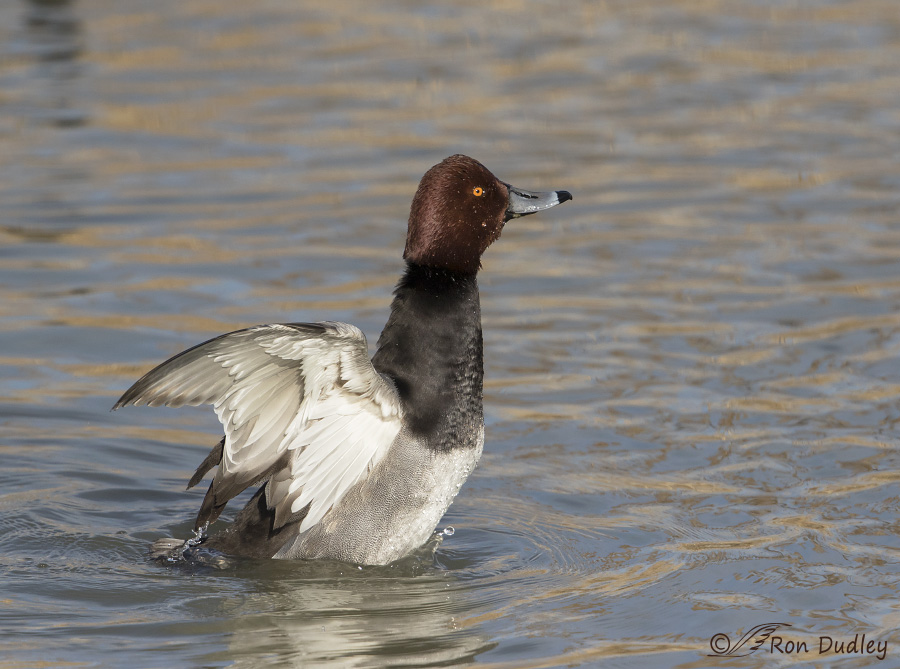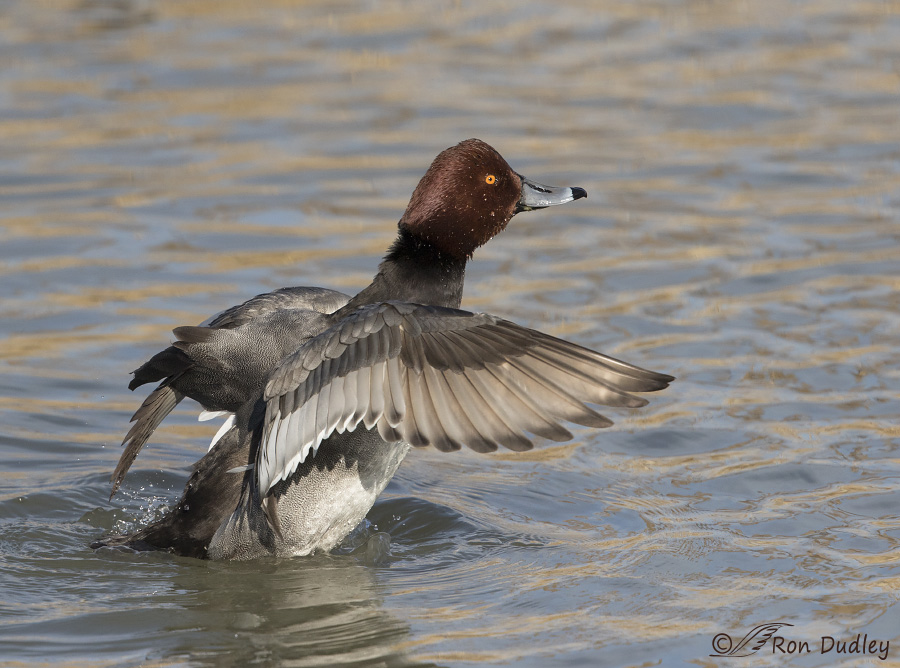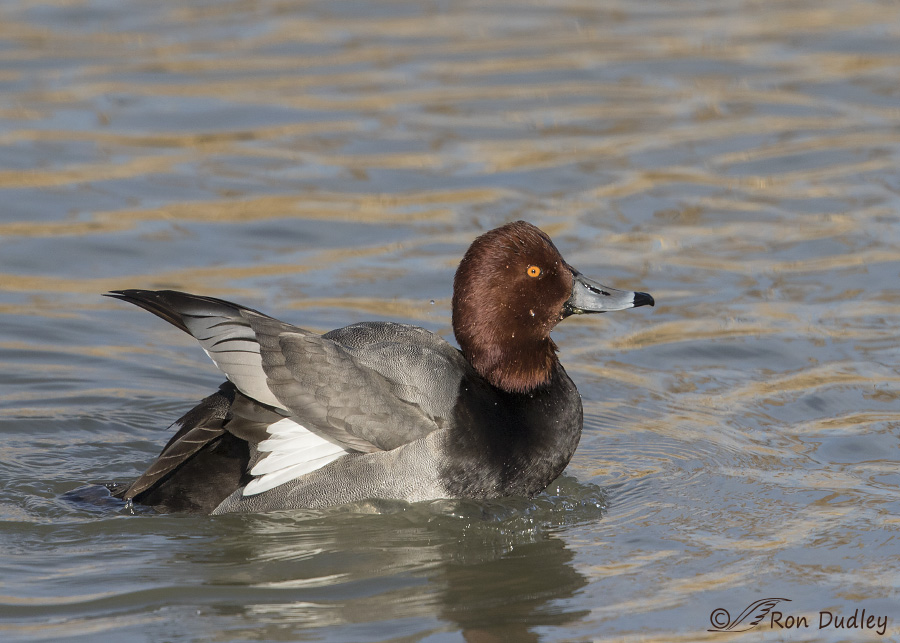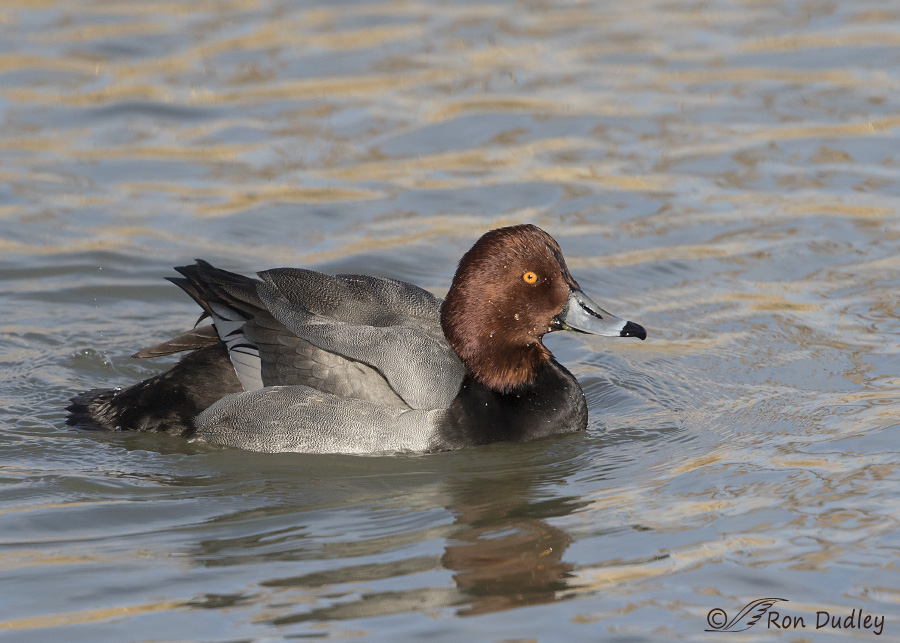Male Redheads are a handsome duck and I’ll photograph them every chance I get. Interesting poses are a bonus.

1/5000, f/6.3, ISO 800, Canon 7D Mark II, Canon EF 500mm f/4L IS II USM + 1.4 tc, not baited, set up or called in
This one spent a few days at Farmington Bay WMA last month and he gave me several wing flaps with results that I like pretty well. This shot was a difficult exposure because of the very bright underwing whites that had direct sunlight on them. Those whites aren’t blown but there’s not a lot of detail in some of them.

1/5000, f/6.3, ISO 800, Canon 7D Mark II, Canon EF 500mm f/4L IS II USM + 1.4 tc, not baited, set up or called in
Four frames later I got a nice look at much of his dorsal plumage. The right wingtip is only slightly soft which is obviously a depth of field issue at this shutter speed.

1/5000, f/6.3, ISO 800, Canon 7D Mark II, Canon EF 500mm f/4L IS II USM + 1.4 tc, not baited, set up or called in
As he settled back down into the water and began to resettle his wings I caught one of them in an asymmetrical position (relative to the other one) that appeals to me.

1/4000, f/6.3, ISO 800, Canon 7D Mark II, Canon EF 500mm f/4L IS II USM + 1.4 tc, not baited, set up or called in
Here he has completely settled back into the water though he’s still trying to get his right wing into a comfortable position.
Redheads are strictly a North American species and they’re highly gregarious, often found in flocks of many thousands. Their sociality has made them highly popular with duck hunters because they can be brought into decoys in large numbers and with great ease. In fact they’re well-known for alighting in the midst of decoys while hunters are still setting them up. This tendency has earned them the name “the fool duck”.
Because of their gregarious nature and their tendency to sit in the water in large, tight flocks they’re also called “the raft duck”. Anyone who has ever seen a huge raft of American Coots will understand why – from a distance that large mass of birds on the water can actually resemble a raft.
Ron


Great captures of this handsome fellow!
Thank you, Jane.
What an absolute beauty.
Echoing Patty’s comments. She has this really unhygenic habit of taking the words from my mouth (first). Trophy hunting does my head in. I really don’t understand killing things for fun. And don’t want to.
“She has this really unhygenic habit of taking the words from my mouth (first)”
That brings up a visual that might keep me from sleeping tonight, EC. Thanks for the giggle and for your entertaining way with words!
Why do people have to hunt? An ornithologist friend of mine from Texas came to tour Chile and Argentina for two months and was positively surprised to discover that people virtually do not hunt ducks in this part of the world. Consequently water birds are incredibly friendly here and tolerate human proximity. What’s the pleasure of shooting these defenseless natural beauties? I just can’t get it.
Different strokes I guess, Ricardo. My own opinions regarding hunting are complicated and have changed over the years. Personally I don’t hunt but I have several friends who do. Truly ethical hunting doesn’t bother me much but sadly, in my experience, ethical hunting is a relatively rare commodity.
Interesting, I had no idea that hunting waterfowl is basically not done in Chile and Argentina.
One reason I like ducks, is that, unlike myself,they’re always smiling…..
Not only are these beautiful images of a beautiful duck, but love the colors and patterns in the water, too…sad how easily these innocent, trusting creatures are deceived by hunters…..at least duck hunters usually eat what they kill (I hope!) and don’t usually kill just to mount the heads on their walls…(there are a couple of “hunters”, like the Minn. dentist),whose head I’d like to see on my wall)…..seeing that on my wall every morning would be ALMOST as pleasing as waking up to your blog…….
Patty, Sadly, there are also “trophy” duck hunters – those that make every attempt to bag all species in a certain group (teals for example) or rare or unusual species. You may recall the “hunters” that killed the rare Long-tailed Duck along the Antelope Causeway a couple of years ago (I blogged about it). They often find those rare ducks by surreptitiously following birding listservs.
Creeps! Would love see them mounted on a wall….naked or in full hunting gear…..At least I can dream….
I like the asymmetrical one. He almost seems to be rolling over.
“He almost seems to be rolling over”
I see what you mean, Arwen.
To a carver like me who paints his carvings, your images are not only exceptional, but a huge help in color, texture and tone. When ever I get out of all the work I have at the moment and sit down with these pictures you can bet I’ll be dong a carving of a Redhead. However, the interesting thing at the moment, which pose will I carve? I love all these different poses that you show.
Great shots Ron!
Choices, choices, huh, Dick? Just forget about all that work and get to carving!
Dick– do you always carve full, life sized or ever carve smaller sizes and mini’s. Did you ever carve a Screech owl?
Patty, I started carving by entering my full, life sized carvings into competition in the 80’s. Each carving took between 100-150 hours, long time. All my carvings since 2000 has been half-sized. Not done mini. I tend to like being able to carve life like feather patterns which gives the bird a life-like appeal. Never have felt I could do that with a mini.
Actually I really like raptors and owls, but unfortunately have never patterned one to carve.
He is a beauty. 🙂 I haven’t seen them often, but know hunters/bird watchers at Freeze Out and Benton Lakes do. Nice detail. 🙂 The tc/s. can help or not – I’ve seen some not so good results and then great results like yours.
Judy, I’ve heard about Freeze Out often but I’ve never been there, even when I lived in Montana.
To get good results using a tc you usually have to have it mounted to a high quality lens.
What a beauty he is, Ron!! I especially like the 3rd photo with that right wing trying to get back in position! I’m just beginning to learn about the different ducks from you. Even though I grew up going to “feed the ducks” at our local park which was just a block away, I still know very little about them. So I’m enjoying my up close views and the wonderful classes by you!!
Good, I’m glad you’re learning more about ducks, Jo Ann.
Wonderful shots R9n! The really are pretty!
Charlotte
Thank you, Charlotte.
As always I am impressed with the quality of the images that you produce with your Mark II, 500mm, and the 1/4 tc.
Many systems degrade when a tc is added. Canon seems to have found a way to maintain image quality, and when
superior gear is combined with flawless technique the result is tack sharp images. Well done Ron, again… ;-)))
Roger, I’ve been pleased with image quality using the 1.4 tc from the very beginning when used with the 500mm, even with the older version of the tc before I bought the newer one. The 2x tc was another story, I sold that one soon after I bought it, partly because I didn’t think image quality was quite up to snuff when I used it.